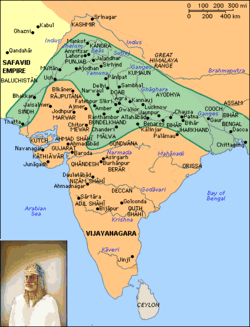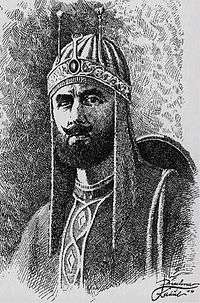Sur Empire
| Sur Empire | ||||||||||||
| د سوریانو ټولواکمني | ||||||||||||
| ||||||||||||
 Territory of Sur Empire in green | ||||||||||||
| Capital | Sasaram (Bihar) | |||||||||||
| Languages | Pashto | |||||||||||
| Religion | Sunni Islam | |||||||||||
| Government | Sultanate | |||||||||||
| History | ||||||||||||
| • | Established | May 17, 1540 | ||||||||||
| • | Disestablished | 1556 | ||||||||||
| ||||||||||||
| Today part of | | |||||||||||
 |
| Part of a series on |
| Pashtuns |
|---|
| Kingdoms |
| Religion |
The Sur Empire (Pashto: د سوریانو ټولواکمني) was an empire established by a Muslim dynasty of Pashtun origin who ruled a large territory in Northern part of South Asia[1] for nearly 16 years, between 1540 and 1556, with Delhi serving as its capital.[2] It interrupted the rule of the Mughal Empire under Humayun, who later restored the Mughal Empire by ending the Sur Empire.
History
The empire was founded by Sher Shah Suri, an ethnic Pashtun of the tribal house of Sur,[1] who supplanted the Mughal dynasty as rulers of North India during the reign of the relatively ineffectual second Mughal Humayun. Sher Shah defeated badhsah-i-Hind ('Hindustani emperor') Humayun in the Battle of Chausa (June 26, 1539) and again in the Battle of Bilgram (May 17, 1540).[3]
The Sur dynasty held control of nearly all the Mughal territories, from modern-day eastern Afghanistan in the west to Bengal in modern-day Bangladesh in the east.
During the almost 17 year rule of the Sur dynasty, until the return of the Mughals to the throne, the region of the South Asia witnessed much economic development and administrative reforms. A systematized relationship was created between the people and the ruler, minimizing corruption and the oppression of the public.
Their rule came to an end by a defeat that led to restoration of the Mughal Empire. Today, the Sur are part of the Pashtun tribal system and belong to the sub-groups of the Ghilzais.
It was at the time of this bounty of Sultán Bahlol [Lodi], that the grandfather of Sher Sháh, by name Ibráhím Khán Súr,*[The Súr represent themselves as descendants of Muhammad Súr, one of the princes of the house of the Ghorian, who left his native country, and married a daughter of one of the Afghán chiefs of Roh.] with his son Hasan Khán, the father of Sher Sháh, came to Hindu-stán from Afghánistán, from a place which is called in the Afghán tongue “Shargarí,”* but in the Multán tongue “Rohrí.” It is a ridge, a spur of the Sulaimán Mountains, about six or seven kos in length, situated on the banks of the Gumal. They entered into the service of Muhabbat Khán Súr, Dáúd Sáhú-khail, to whom Sultán Bahlol had given in jágír the parganas of Hariána and Bahkála, etc., in the Panjáb, and they settled in the pargana of Bajwára.[4]— Abbas Khan Sarwani, 1580
List of Sur dynasty rulers

| Name | Picture | Reign started | Reign ended |
|---|---|---|---|
| Sher Shah Suri |
 |
May 17, 1540[7] | May 22, 1545[7] |
| Islam Shah Suri |
May 26, 1545[8] | November 22, 1554[8] | |
| Firuz Shah Suri |
1554[9] | ||
| Muhammad Adil Shah |
1554[9] | 1555[10] | |
| Ibrahim Shah Suri |
1555[10] | ||
| Sikandar Shah Suri |
1555[10] | June 22, 1555[10] | |
| Adil Shah Suri |
June 22, 1555[10] | 1556[10] |
See also
References
- 1 2 Kissling, H. J.; N. Barbour; Bertold Spuler; J. S. Trimingham; F. R. C. Bagley; H. Braun; H. Hartel (1997). The Last Great Muslim Empires. BRILL. pp. 262–263. ISBN 90-04-02104-3. Retrieved 2011-07-20.
- ↑ "Sūr dynasty". Encyclopædia Britannica Online Online. Retrieved 2010-08-25.
- ↑ "Sher Khan". The Columbia Electronic Encyclopedia, 6th edition. Columbia Encyclopedia. 2007. Retrieved 2010-08-25.
- ↑ Abbas Khan Sarwani (1580). "Táríkh-i Sher Sháhí; or, Tuhfat-i Akbar Sháhí, of 'Abbás Khán Sarwání. CHAPTER I. Account of the reign of Sher Sháh Súr.". Packard Humanities Institute. Retrieved 2010-09-04.
- ↑ Mughal Coinage Reserve Bank of India RBI Monetary Museum,
- ↑ Rupee
 This article incorporates text from a publication now in the public domain: Chisholm, Hugh, ed. (1911). "article name needed". Encyclopædia Britannica (11th ed.). Cambridge University Press..
This article incorporates text from a publication now in the public domain: Chisholm, Hugh, ed. (1911). "article name needed". Encyclopædia Britannica (11th ed.). Cambridge University Press.. - 1 2 Majumdar, R.C. (ed.) (2007). The Mughul Empire, Mumbai: Bharatiya Vidya Bhavan, ISBN 81-7276-407-1, p.83
- 1 2 Majumdar, R.C. (ed.) (2007). The Mughul Empire, Mumbai: Bharatiya Vidya Bhavan, ISBN 81-7276-407-1, pp.90–93
- 1 2 Majumdar, R.C. (ed.) (2007). The Mughul Empire, Mumbai: Bharatiya Vidya Bhavan, ISBN 81-7276-407-1, p.94
- 1 2 3 4 5 6 Majumdar, R.C. (ed.) (2007). The Mughul Empire, Mumbai: Bharatiya Vidya Bhavan, ISBN 81-7276-407-1, pp.94–96
External links
| Wikimedia Commons has media related to Suri Empire. |